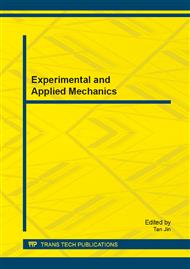p.120
p.126
p.132
p.138
p.144
p.150
p.155
p.161
p.165
Residual Stress Study of Autofrettaged Barrel under Impulsive Loading
Abstract:
An analysis model of barrel was established for rapid-firing gun by using the thermal structure direct coupling analysis method. As a solving tactics, finite element method was employed to analyze the influence of degree of autofrettage on the residual stress of the tube under impact load caused by high temperature and high pressure powder gases during continuous shots process. The results indicated that there is a significant effect of degree of autofrettage on the residual stress distribution of barrel. As the autofrettage level increases, the radius of the compressive tangential plastic strain zone on the inner wall and the maximal residual stress of the base near chromium-steel interface become larger. This is the cause that the tensile tangential plastic strain in the self-reinforced barrel easily occurred in the process of continuous shots after cooling. This goes against stability of the stress condition of the gun tube.
Info:
Periodical:
Pages:
144-149
Citation:
Online since:
February 2014
Authors:
Price:
Сopyright:
© 2014 Trans Tech Publications Ltd. All Rights Reserved
Share:
Citation:


